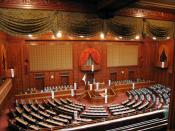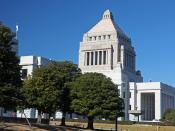Comparison of the Legislative System of Australia and Japan.
Japan's Legislature is called the National Diet of Japan. Similar to the Australian system of parliament, it is a bicameral legislature. In Japan, it is composed of the House of Representatives and the House of Councillors (Also known as House of Chancellors). The House of Representatives acts as the lower house and the House of Councillors acts as the upper house. This legislature is similar to the Australian system, however, the upper house in the Australian Parliament is known as the Senate.
In Japan, the National Diet is considered as "the highest organ of state power" and "the sole law-making organ of the State" based on the Constitution.
The two houses in Japan are primarily responsible for making laws, approving the annual national budget, instigating the Constitutional amendments, independently investigating the Government and impeaching Judges of the judicial branch convicted of unethical conduct.
The Legislature also plays the pivotal role in formally selecting the Prime Minister of Japan.
The lower house of the Diet of Japan has 480 members, elected for an unrenewable four-year term. In Australia the lower house consists of 150 members who are elected for a 3 year term which is renewable once. The Upper House in the Diet of Japan has 242 members who serve six year terms. The Upper House of Australia (Senate) is composed of only 76 members.
Electoral System
Suffrage is compulsory in Japan for all citizens over 20 years of age. In Japan, both the Upper House and Lower House are elected through what is known as the parallel voting system. The parallel voting system is a system of voting where the elections are run separately for both houses and the result of the election in one house has little or no impact...


